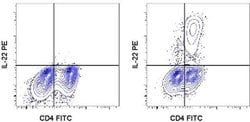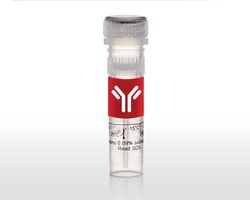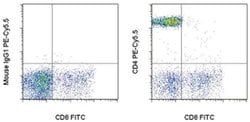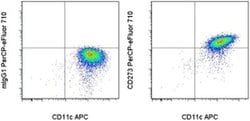IL-22 Monoclonal Antibody (22URTI), PE, eBioscience™, Invitrogen™
Manufacturer: Fischer Scientific
Select a Size
| Pack Size | SKU | Availability | Price |
|---|---|---|---|
| Each of 1 | 50-112-8772-Each-of-1 | In Stock | ₹ 34,354.00 |
50-112-8772 - Each of 1
In Stock
Quantity
1
Base Price: ₹ 34,354.00
GST (18%): ₹ 6,183.72
Total Price: ₹ 40,537.72
Antigen
IL-22
Classification
Monoclonal
Concentration
5 μL/Test
Formulation
PBS with 0.2% BSA and 0.09% sodium azide; pH 7.2
Gene Accession No.
Q9GZX6
Gene Symbols
IL22
Purification Method
Affinity chromatography
Regulatory Status
RUO
Gene ID (Entrez)
50616
Content And Storage
4° C, store in dark, DO NOT FREEZE!
Form
Liquid
Applications
Flow Cytometry
Clone
22URTI
Conjugate
PE
Gene
IL22
Gene Alias
Cytokine Zcyto18; EGK_03903; il 22; IL-10-related T-cell-derived inducible factor; IL-10-related T-cell-derived-inducible factor; IL-21; IL22; IL-22; Il22a; IL-22a; IL-D110; ILN; ILTIF; IL-TIF; ILTIF alpha; IL-TIF alpha; ILTIFa; Interleukin; interleukin 10-related T cell-derived inducible factor; interleukin 22; Interleukin22; interleukin-22; Interleukin-22a; RGD1561292; TIFa; TIFIL-23; UNQ3099/PRO10096; ZCYTO18
Host Species
Mouse
Quantity
100 Tests
Primary or Secondary
Primary
Target Species
Human
Product Type
Antibody
Isotype
IgG1 κ
Description
- Description: The 22URTI monoclonal antibody reacts with human interleukin(IL)-22
- IL-22 is a 20 kDa member of the IL-10 cytokine family that is secreted primarily by Th17 and NK cells
- Nevertheless, other T cells have also been shown to produce IL-22
- In in vitro Th17 cultures, induction of IL-22 expression is greater in response to IL-23 than IL-6 or TGF beta, suggesting that this cytokine may be secreted by more fully differentiated Th17 cells in vivo
- A heterodimer consisting of IL-10R2 and IL-22R1 serves as the receptor for IL-22
- Applications Reported: This 22URTI antibody has been reported for use in intracellular staining followed by flow cytometric analysis
- Applications Tested: This 22URTI antibody has been pre-titrated and tested by intracellular staining followed by flow cytometric analysis of restimulated, Th17-polarized CD4+ normal human peripheral blood cells or stimulated total normal human peripheral blood cells
- This can be used at 5 μL (0.01 μg) per test
- A test is defined as the amount (μg) of antibody that will stain a cell sample in a final volume of 100 μL
- Cell number should be determined empirically but can range from 10^5 to 10^8 cells/test
- Excitation: 488-561 nm; Emission: 578 nm; Laser: Blue Laser, Green Laser, Yellow-Green Laser
- Filtration: 0.2 μm post-manufacturing filtered
- IL-22 also known as IL-10-related T-cell derived inducible factor, is an alpha helical cytokine and is considered a member of the IFN-IL-10 family, which includes IL-19, IL-20, IL-24, IL-26, IL-28, IL-29, and the type I and II interferons
- IL-22 is produced mainly by activated T cells and NK cells
- In humans, the IL-22 gene is located on the q arm of chromosome 12, and is structurally related to IL10
- IL-22 acts by engaging the heterodimeric receptor complex consisting of primary receptor IL-22R1 and accessory receptor IL-10R2
- IL-22R1 also binds IL-20 and IL-24; IL-10R2 also binds IL-10, IL-27, IL-28, and IL-29
- Binding of IL-22 to its receptor complex induces signal transduction, particularly via the JAK-STAT pathway
- In addition to the membrane-bound IL-22R1/IL-10R2 complex, a soluble single-chain IL-22 receptor termed IL-22BP has been found to antagonize IL-22 binding and signaling
- IL-22 appears not to directly influence immune cells, and major targets of the cytokine appear to be nonimmune cells, such as cells of the skin, digestive and respiratory system, as well as hepatocytes, and keratinocytes
- IL-22 has been described as an effector cytokine of the Th17 lineage
- Along with IL-17A and IL-17F, IL-22 regulates genes associated with innate immunity of the skin
- IL-17A, IL-17F and IL-22 are all co-expressed by Th17 cells, however, they are differentially regulated
- The effects of IL-22 include induction of acute phase reactants and antimicrobial proteins, as well as increasing the mobility of keratinocytes
- IL-22 is highly expressed during chronic inflammation, and found to activate intracellular kinases and transcription factors
- IL-22 is critical for host defense against infections of extracellular pathogens, and promotes wound-healing responses
- IL-22 is upregulated in activated T cells
- IL-22 has been reported to mediate IL-23-induced acanthosis and dermal inflammation through activation of STAT3.



